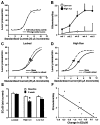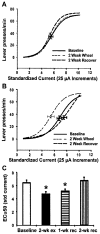Voluntary running-wheel exercise decreases the threshold for rewarding intracranial self-stimulation
- PMID: 22845707
- PMCID: PMC4433312
- DOI: 10.1037/a0029149
Voluntary running-wheel exercise decreases the threshold for rewarding intracranial self-stimulation
Abstract
Physical exercise has mood-enhancing and antidepressant properties although the mechanisms underlying these effects are not known. The present experiment investigated the effects of prolonged access to a running wheel on electrical self-stimulation of the lateral hypothalamus (LHSS), a measure of hedonic state, in rats. Rats with continuous voluntary access to a running wheel for either 2 or 5 weeks exhibited dramatic leftward shifts in the effective current 50 (ECu50; current value that supports half of maximum responding) of their LHSS current-response functions compared to their baselines, indicating a decrease in reward threshold, whereas control rats current-response functions after 2 or 5 weeks were not significantly different from baseline. An inverse correlation existed between the change in ECu50 from baseline and the amount an animal had run in the day prior to LHSS testing, indicating that animals that exhibited higher levels of running showed a more robust decrease in LHSS threshold. We conclude that long-term voluntary exercise increases sensitivity to rewarding stimuli, which may contribute to its antidepressant properties.
Figures


Similar articles
-
Long-term voluntary wheel running is rewarding and produces plasticity in the mesolimbic reward pathway.Behav Brain Res. 2011 Mar 1;217(2):354-62. doi: 10.1016/j.bbr.2010.11.005. Epub 2010 Nov 9. Behav Brain Res. 2011. PMID: 21070820 Free PMC article.
-
A search for the metabolic signal that sensitizes lateral hypothalamic self-stimulation in food-restricted rats.Physiol Behav. 1998 Jun 1;64(3):251-60. doi: 10.1016/s0031-9384(98)00050-x. Physiol Behav. 1998. PMID: 9748090
-
Mineralocorticoid receptor antagonism prevents hedonic deficits induced by a chronic sodium appetite.Behav Neurosci. 2010 Apr;124(2):211-24. doi: 10.1037/a0018910. Behav Neurosci. 2010. PMID: 20364881 Free PMC article.
-
The use of a running wheel to measure activity in rodents: relationship to energy balance, general activity, and reward.Neurosci Biobehav Rev. 2012 Mar;36(3):1001-1014. doi: 10.1016/j.neubiorev.2011.12.012. Epub 2012 Jan 2. Neurosci Biobehav Rev. 2012. PMID: 22230703 Free PMC article. Review.
-
Differential rewarding effects of electrical stimulation of the lateral hypothalamus and parabrachial complex: Functional characterization and the relevance of opioid systems and dopamine.J Psychopharmacol. 2019 Dec;33(12):1475-1490. doi: 10.1177/0269881119855982. Epub 2019 Jul 8. J Psychopharmacol. 2019. PMID: 31282233 Review.
Cited by
-
Reduced exploratory behavior in neuronal nucleoredoxin knockout mice.Redox Biol. 2021 Sep;45:102054. doi: 10.1016/j.redox.2021.102054. Epub 2021 Jun 23. Redox Biol. 2021. PMID: 34198070 Free PMC article.
-
Role of DNA methylation and the DNA methyltransferases in learning and memory.Dialogues Clin Neurosci. 2014 Sep;16(3):359-71. doi: 10.31887/DCNS.2014.16.3/mmorris. Dialogues Clin Neurosci. 2014. PMID: 25364286 Free PMC article. Review.
-
Pharmacological targeting of the mammalian clock regulates sleep architecture and emotional behaviour.Nat Commun. 2014 Dec 23;5:5759. doi: 10.1038/ncomms6759. Nat Commun. 2014. PMID: 25536025 Free PMC article.
-
A Possible Role of Anhedonia as Common Substrate for Depression and Anxiety.Depress Res Treat. 2016;2016:1598130. doi: 10.1155/2016/1598130. Epub 2016 Mar 2. Depress Res Treat. 2016. PMID: 27042346 Free PMC article. Review.
-
A murine model of peripheral irradiation-induced fatigue.Behav Brain Res. 2016 Jul 1;307:218-26. doi: 10.1016/j.bbr.2016.03.035. Epub 2016 Mar 21. Behav Brain Res. 2016. PMID: 27012391 Free PMC article.
References
-
- Babyak M, Blumenthal JA, Herman S, Khatri P, Doraiswamy M, Moore K, Krishnan KR. Exercise treatment for major depression: Maintenance of therapeutic benefit at 10 months. Psychosomatic Medicine. 2000;62:633–638. - PubMed
Publication types
MeSH terms
Grants and funding
LinkOut - more resources
Full Text Sources
Medical

